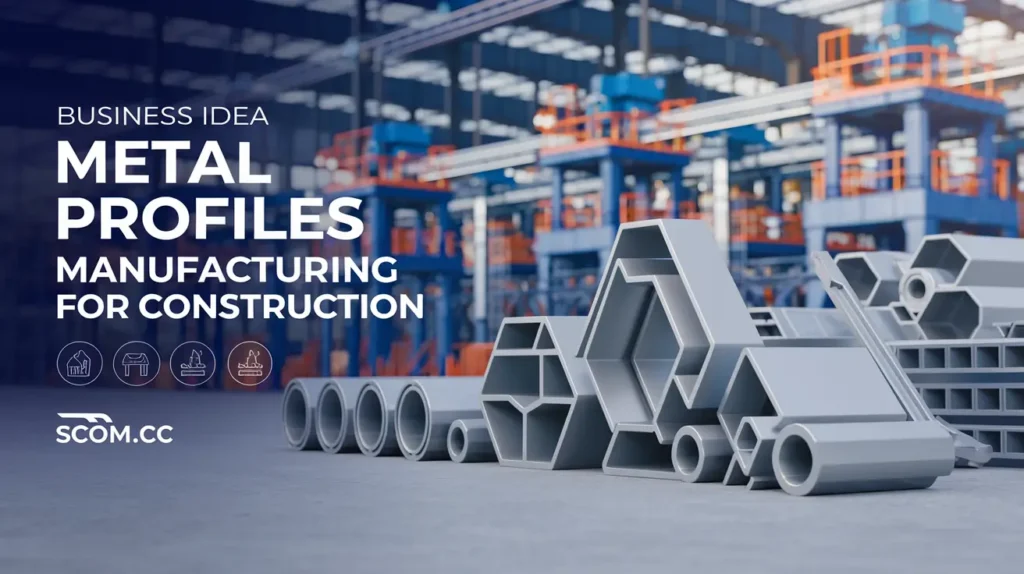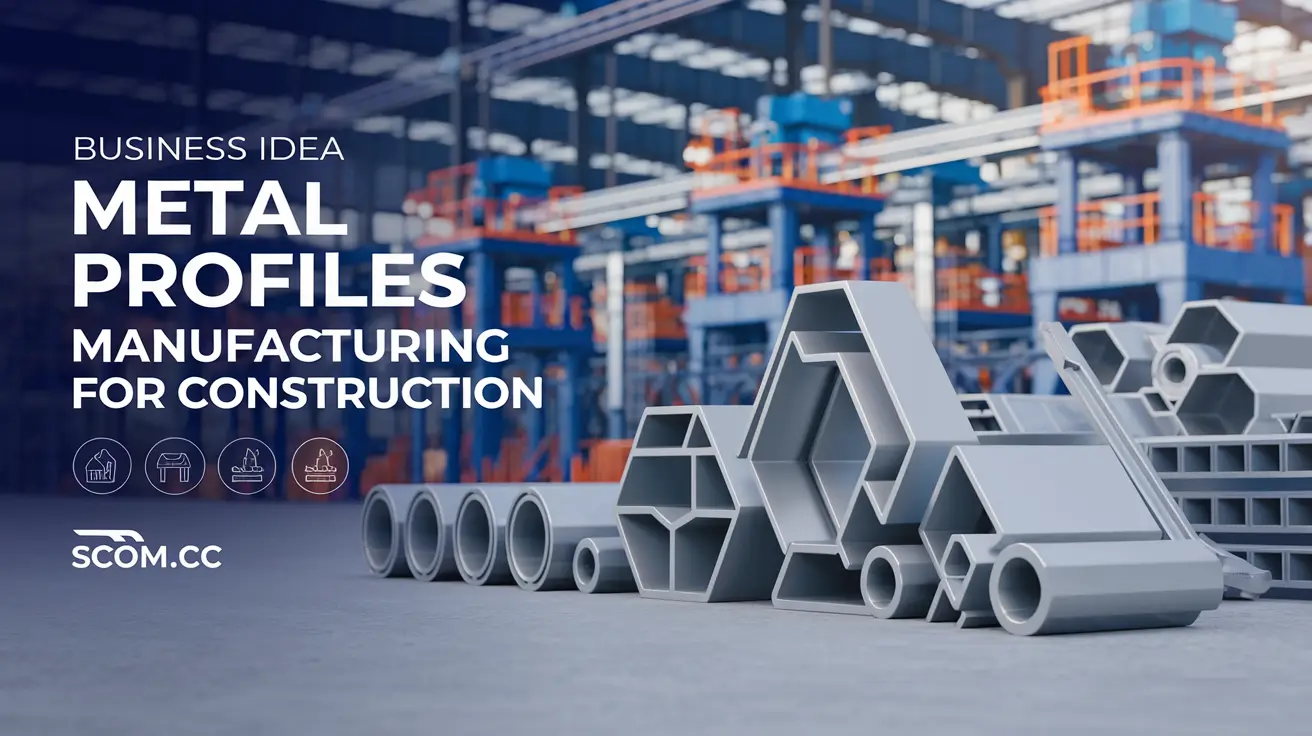Business Idea Metal Profiles Manufacturing for Construction

- Business Idea Metal Profiles Manufacturing for Construction
- Introduction to Metal Profiles Manufacturing for Construction
- What Are Metal Profiles?
- Market Potential for Metal Profiles Manufacturing
- Initial Costs and Investment
- Benefits of Metal Profiles Manufacturing
- Challenges and Considerations
- Legal and Regulatory Aspects
- Marketing and Placement Strategies
- Future Trends and Innovations
- Conclusion
- Summary Table
-
FAQ
- What are metal profiles used for in construction?
- What are the initial costs for starting a metal profiles manufacturing business?
- What are the main benefits of manufacturing metal profiles?
- What challenges might businesses face in metal profiles manufacturing?
- What legal and regulatory aspects should be considered?
- How can businesses effectively market their metal profiles manufacturing services?
- What are the future trends in metal profiles manufacturing?
Business Idea Metal Profiles Manufacturing for Construction
Metal Profiles Manufacturing for Construction: A Comprehensive Guide
We specialize in the production of metal profiles using advanced machinery, catering to the needs of the construction and repair sectors. Our state-of-the-art equipment allows us to create precise and durable metal components essential for modern infrastructure projects and maintenance services. With a focus on quality and efficiency, we deliver tailored solutions that support the growth and sustainability of these vital industries.
Introduction to Metal Profiles Manufacturing for Construction
Metal profiles manufacturing plays a crucial role in the construction industry, providing essential components for a variety of structural and architectural applications. By leveraging specialized machinery, businesses can produce high-quality metal profiles tailored to the needs of the construction and repair sectors. This guide explores the concept of metal profiles manufacturing, including its market potential, benefits, costs, and key considerations for establishing a successful manufacturing operation.
What Are Metal Profiles?
Metal profiles refer to various shapes and sections made from metal, used in construction for structural support, framing, and other applications. These profiles are produced using specialized machinery and can be made from materials such as steel, aluminum, or other alloys.
Types of Metal Profiles
- I-Beams: Used for structural support in buildings and bridges.
- C-Channels: Commonly used for framing and structural applications.
- Angle Iron: Used in various structural and reinforcement applications.
- T-Beams: Employed in construction for support and stability.
- U-Channels: Utilized in various structural and support roles.
Market Potential for Metal Profiles Manufacturing
The demand for metal profiles in the construction industry is driven by ongoing infrastructure projects, new building constructions, and renovations. As urbanization and industrial activities grow, the need for high-quality metal profiles continues to rise.
Target Markets
- Construction Companies: Builders and contractors requiring metal profiles for new constructions and renovations.
- Architectural Firms: Professionals needing custom metal profiles for unique design elements.
- Repair and Maintenance Services: Businesses involved in repairing and maintaining existing structures.
- Industrial Applications: Manufacturers and industries using metal profiles for machinery and equipment.
Initial Costs and Investment
Starting a metal profiles manufacturing business involves several initial costs, including the purchase of machinery, raw materials, and setup expenses. Proper budgeting and financial planning are essential for a successful launch.
Cost Breakdown
- Machinery: Specialized machines for metal profiling can range from $50,000 to $200,000, depending on capabilities and automation levels.
- Raw Materials: Costs for acquiring metal sheets, coils, or billets, which can vary based on material type and quantity.
- Setup and Installation: Expenses for setting up the manufacturing facility, including installation of machinery, utilities, and workspace.
- Labor and Training: Costs associated with hiring skilled labor and providing training for operating machinery.
Benefits of Metal Profiles Manufacturing
Manufacturing metal profiles offers several advantages, particularly in terms of meeting the specific needs of the construction and repair industries. These benefits make it an attractive business opportunity.
Advantages
- Customization: Ability to produce custom profiles tailored to specific project requirements.
- High Demand: Ongoing need for metal profiles in various construction and industrial applications.
- Scalability: Potential for scaling operations to meet increasing demand or diversify product offerings.
- Durability: Metal profiles offer long-lasting and robust solutions for structural and architectural needs.
Challenges and Considerations
While metal profiles manufacturing presents significant opportunities, there are challenges that businesses must address. Effective management and strategic planning are essential for overcoming these obstacles.
Common Challenges
- High Initial Investment: Significant capital required for purchasing machinery and setting up the facility.
- Material Costs: Fluctuating prices for raw materials can impact profitability.
- Market Competition: Competition from other manufacturers and suppliers in the industry.
- Regulatory Compliance: Adherence to industry standards and regulations for quality and safety.
Legal and Regulatory Aspects
Operating a metal profiles manufacturing business involves complying with various legal and regulatory requirements. Ensuring adherence to these regulations is crucial for maintaining product quality and safety.
Key Regulations
- Quality Standards: Compliance with industry standards for metal profiles, including specifications for strength and durability.
- Safety Regulations: Adherence to workplace safety regulations, including machinery operation and employee safety.
- Environmental Regulations: Compliance with environmental regulations related to waste management and emissions.
- Licensing and Permits: Obtaining necessary licenses and permits for manufacturing and business operations.
Marketing and Placement Strategies
Effective marketing and placement strategies are essential for promoting metal profiles manufacturing services and reaching potential clients. Developing a strong market presence can enhance visibility and attract business.
Marketing Tips
- Highlight Capabilities: Showcase the range of metal profiles offered and customization options.
- Target Specific Industries: Focus marketing efforts on construction companies, architectural firms, and industrial applications.
- Build a Strong Brand: Develop a professional brand image and online presence to attract clients.
- Leverage Industry Networks: Engage with industry associations and networks to build connections and gain referrals.
Future Trends and Innovations
The metal profiles manufacturing industry is evolving with new trends and innovations. Staying informed about these developments can provide a competitive edge and help businesses adapt to changing market demands.
Emerging Trends
- Advanced Manufacturing Technologies: Integration of automation, robotics, and advanced materials for improved efficiency and quality.
- Sustainable Practices: Adoption of eco-friendly practices, including recycling and reduced energy consumption.
- Customisation and Personalisation: Increased focus on providing highly customized profiles for specific project needs.
- Digital Integration: Use of digital tools for design, production planning, and quality control.
Conclusion
Metal profiles manufacturing for construction offers a valuable opportunity to supply high-quality, customized components for a range of applications. By understanding the market potential, managing initial costs, and addressing challenges, businesses can successfully establish and grow their operations. With a focus on innovation, quality, and effective marketing, this business model can meet the increasing demand for metal profiles in the construction and repair industries.
Summary Table
| Aspect | Details |
|---|---|
| Product | Metal profiles for construction |
| Key Features | Customizable shapes and sizes, high-quality materials, specialized machinery |
| Target Markets | Construction companies, architectural firms, repair and maintenance services, industrial applications |
| Initial Costs | $50,000 to $200,000 for machinery, plus raw materials, setup, and labor expenses |
| Benefits | Customization, high demand, scalability, durability |
| Challenges | High initial investment, material costs, market competition, regulatory compliance |
| Legal Requirements | Quality standards, safety regulations, environmental regulations, licensing and permits |
| Marketing Strategies | Highlight capabilities, target specific industries, build a strong brand, leverage industry networks |
| Future Trends | Advanced manufacturing technologies, sustainable practices, customization, digital integration |
FAQ
What are metal profiles used for in construction?
Metal profiles are used in construction for structural support, framing, and various architectural applications. They provide essential reinforcement and shape to buildings and infrastructure.
What are the initial costs for starting a metal profiles manufacturing business?
Initial costs include $50,000 to $200,000 for purchasing specialized machinery, plus expenses for raw materials, setup, installation, and labor.
What are the main benefits of manufacturing metal profiles?
Benefits include the ability to customize products, high market demand, scalability, and the durability of metal profiles.
What challenges might businesses face in metal profiles manufacturing?
Challenges include high initial investment, fluctuating material costs, market competition, and the need to comply with regulatory standards.
What legal and regulatory aspects should be considered?
Businesses must adhere to quality standards, safety regulations, environmental regulations, and obtain necessary licenses and permits.
How can businesses effectively market their metal profiles manufacturing services?
Effective marketing strategies include highlighting capabilities, targeting specific industries, building a strong brand, and leveraging industry networks.
What are the future trends in metal profiles manufacturing?
Emerging trends include advanced manufacturing technologies, sustainable practices, increased customization, and digital integration in production processes.

If you enjoyed this article and found it valuable, we encourage you to explore our news and valuable information section, where you'll find more relevant and up-to-date content that may pique your interest. Additionally, if you are seeking advice or need guidance on a specific topic, we suggest visiting our services section. There, you will find a variety of options designed to assist and support you in addressing your needs. Feel free to check out both sections to get the information and assistance that best suits your requirements.

Leave a Reply